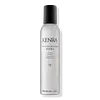What's inside
What's inside
 Concerns
Concerns

 Ingredients Side-by-side
Ingredients Side-by-side

Water
Skin ConditioningVp/Va Copolymer
Propane
Butane
Polyquaternium-11
Isobutane
Phenoxyethanol
PreservativeSteareth-21
CleansingParfum
MaskingCocamidopropyl Betaine
CleansingEthylhexylglycerin
Skin ConditioningPPG-5-Ceteth-20
EmulsifyingHydrolyzed Wheat Protein
Skin ConditioningPEG-12 Dimethicone
Skin ConditioningBenzophenone-4
UV AbsorberSodium Chloride
MaskingPotassium Sorbate
PreservativeSodium Benzoate
MaskingSodium Hydroxide
BufferingCitric Acid
BufferingLimonene
PerfumingBenzyl Salicylate
PerfumingBenzyl Alcohol
PerfumingHexyl Cinnamal
PerfumingLinalool
PerfumingGeraniol
PerfumingAmyl Cinnamal
PerfumingWater, Vp/Va Copolymer, Propane, Butane, Polyquaternium-11, Isobutane, Phenoxyethanol, Steareth-21, Parfum, Cocamidopropyl Betaine, Ethylhexylglycerin, PPG-5-Ceteth-20, Hydrolyzed Wheat Protein, PEG-12 Dimethicone, Benzophenone-4, Sodium Chloride, Potassium Sorbate, Sodium Benzoate, Sodium Hydroxide, Citric Acid, Limonene, Benzyl Salicylate, Benzyl Alcohol, Hexyl Cinnamal, Linalool, Geraniol, Amyl Cinnamal
Ingredients Explained
These ingredients are found in both products.
Ingredients higher up in an ingredient list are typically present in a larger amount.
Hexyl Cinnamal is a fragrance ingredient with a similar scent to jasmine. It can be naturally found in chamomile essential oil.
This ingredient is a known EU allergen and may sensitize the skin. The EU requires this ingredient to be listed separately on an ingredients list.
Hexyl Cinnamal is not water soluble but is soluble in oils.
Learn more about Hexyl CinnamalWe don't have a description for Isobutane yet.
Linalool is a fragrance and helps add scent to products. It's derived from common plants such as cinnamon, mint, citrus, and lavender.
Like Limonene, this ingredient oxidizes when exposed to air. Oxidized linalool can cause allergies and skin sensitivity.
This ingredient has a scent that is floral, spicy tropical, and citrus-like.
Learn more about LinaloolParfum is a catch-all term for an ingredient or more that is used to give a scent to products.
Also called "fragrance", this ingredient can be a blend of hundreds of chemicals or plant oils. This means every product with "fragrance" or "parfum" in the ingredients list is a different mixture.
For instance, Habanolide is a proprietary trade name for a specific aroma chemical. When used as a fragrance ingredient in cosmetics, most aroma chemicals fall under the broad labeling category of “FRAGRANCE” or “PARFUM” according to EU and US regulations.
The term 'parfum' or 'fragrance' is not regulated in many countries. In many cases, it is up to the brand to define this term.
For instance, many brands choose to label themselves as "fragrance-free" because they are not using synthetic fragrances. However, their products may still contain ingredients such as essential oils that are considered a fragrance by INCI standards.
One example is Calendula flower extract. Calendula is an essential oil that still imparts a scent or 'fragrance'.
Depending on the blend, the ingredients in the mixture can cause allergies and sensitivities on the skin. Some ingredients that are known EU allergens include linalool and citronellol.
Parfum can also be used to mask or cover an unpleasant scent.
The bottom line is: not all fragrances/parfum/ingredients are created equally. If you are worried about fragrances, we recommend taking a closer look at an ingredient. And of course, we always recommend speaking with a professional.
Learn more about ParfumPhenoxyethanol is a preservative that has germicide, antimicrobial, and aromatic properties. Studies show that phenoxyethanol can prevent microbial growth. By itself, it has a scent that is similar to that of a rose.
It's often used in formulations along with Caprylyl Glycol to preserve the shelf life of products.
Propane is a gas derived from petroleum and natural gas. It is used as a propellant.
This ingredient is most commonly used in shaving cream, hair products, and makeup.
Water. It's the most common cosmetic ingredient of all. You'll usually see it at the top of ingredient lists, meaning that it makes up the largest part of the product.
So why is it so popular? Water most often acts as a solvent - this means that it helps dissolve other ingredients into the formulation.
You'll also recognize water as that liquid we all need to stay alive. If you see this, drink a glass of water. Stay hydrated!
Learn more about Water